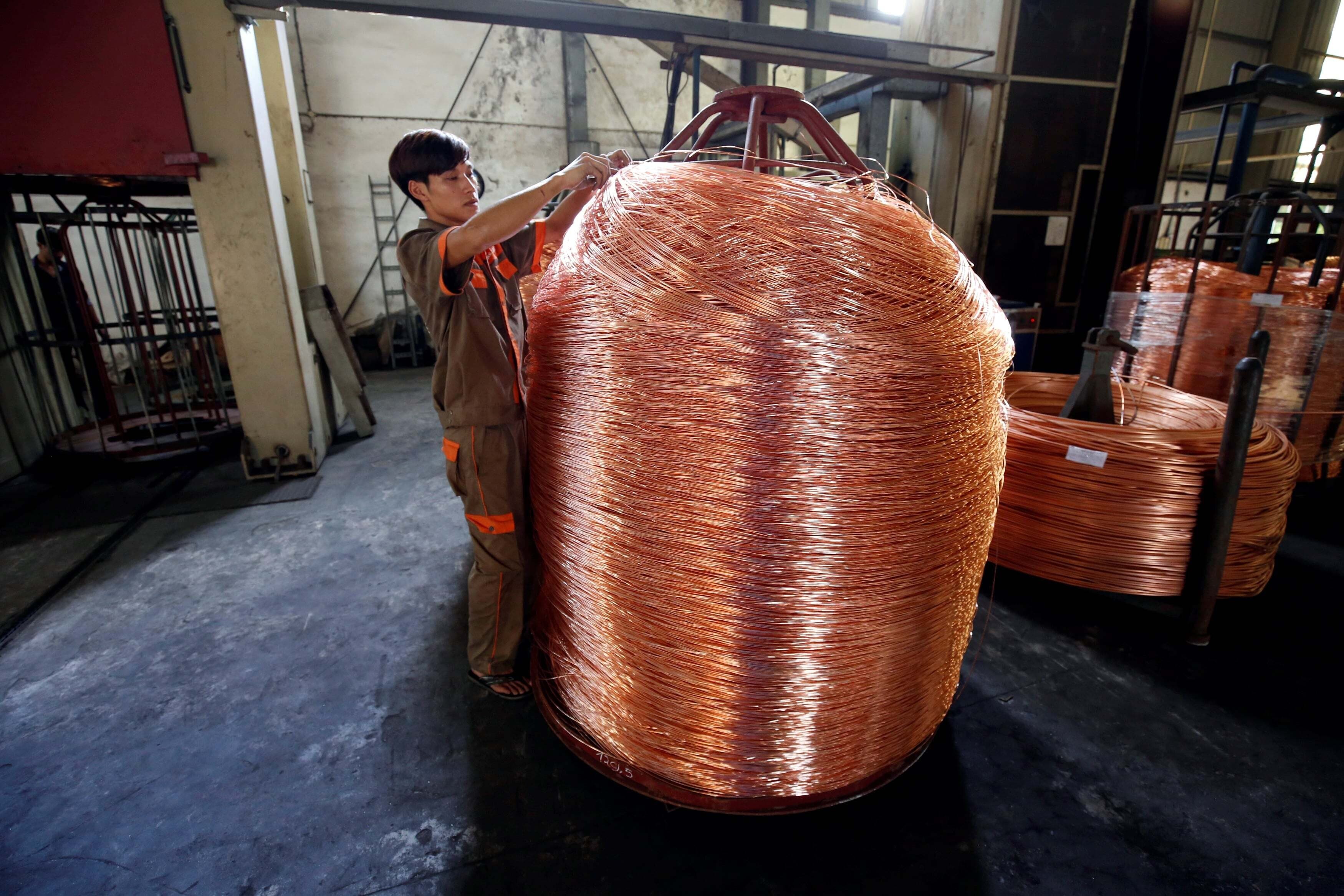Are emerging economies deindustrializing too quickly?
We are seeing that emerging economies are deindustrializing more quickly and we need to pay attention.
Image: REUTERS/Ivan Alvarado
Stay up to date:
Economic Progress
As today’s developed countries grew richer, they experienced a process of ‘structural transformation’. This means they first went through a period of industrialization as the economic center of gravity shifted from agriculture to manufacturing, and then went through a period of deindustrialization, shifting the weight from manufacturing to services. In a companion blog post we discuss this pattern in more detail.
How does this compare to the more recent experience of emerging economies? Are today’s developing countries following a similar process of structural transformation?
In this blog post we show that the patterns of structural transformation in developing countries are different to those of advanced, post-industrial economies. Specifically, we show that emerging economies have been deindustrializing more quickly. We explain how and why this is happening, and whether we should be worried about it.
In the first section we explore broad trends of industrialisation, and after pointing out the common patterns, we turn to an analysis of the particular aspects that make structural transformation in today’s low income countries different, and perhaps problematic.
Industry
One way to study the process of ‘structural transformation’ across countries is to track how employment changes across sectors in the economy. The below chart does this, plotting the share of industry in total employment (vertical axis) against GDP per head (horizontal axis). This graph is a ‘connected scatter plot’ – each line shows the trajectory that a country followed over time along these two dimensions. Data is available for a selection of more than 40 countries, across all continents.
There is a lot going on in this chart. But on the aggregate, it is easy to see a pattern: there is a hump-shaped relationship between industrialization (measured by employment shares) and incomes. In low and high income countries the share working in industrial sectors is low.
As we can see, at low levels of GDP per head, economic growth tends to go together with a rising share of employment in industry; then at an intermediate point in national incomes, the industrial sector reaches a peak; and after that point the relationship is inverted and further economic growth goes together with a lower share of employment in the industrial sector.
Of course, this broad inverted U-shape pattern is not shared by all countries. See for example Colombia. And even among countries that do fit the pattern, we can see some interesting variations.
For example, the height of the ‘humps’ varies widely across countries. Indeed, the highest peaks in industry employment shares took place in the earliest industrializers: Belgium, France, Germany, Sweden and the UK all reached shares above 40% before beginning to deindustrialize (more on this here). Outside Europe, the only countries to have reached comparable levels of industrialization are Mauritius and Taiwan.
You can use the slider at the bottom of this chart to change the time settings. If you move the left point of the slider all the way to 2010, the chart will show a snapshot of the cross-country correlation between average national incomes and the share of employment in industry. Doing this reveals that the cross-country correlation at any point in time is similar to the within-country correlation across time. This means that in the cross-section, the poorest and richest countries have some of the lowest shares of employment in industrial sectors while for individual countries over time, the lowest industry shares correspond to the periods with lowest and highest recorded income levels.
Accept our marketing cookies to access this content.
These cookies are currently disabled in your browser.
Another way to explore the relative importance of manufacturing and other industrial sectors is to look at their importance in the country’s total output. This is shown in the next chart, plotting the share of industry in total GDP (vertical axis), against GDP per capita (horizontal axis).
Although the same broad hump-shaped pattern holds, there are two important points here that deserve more discussion.
The first point to note is that in the chart below, countries such as Botswana, Zambia, Nigeria and Venezuela have an extremely large share of industry in GDP vis-a-vis their industry employment shares. This difference can be attributed to the fact that these countries are major natural resource exporters. The mining or oil extraction industries that show up in the data as part of ‘industry’ are usually very capital intensive and generate a lot of revenue relative to the quantity of labor employed.1
The second point to note is that the observed patterns depend on the actual measure used to capture the relative importance of each sector. Put simply: the hump-shaped pattern is different if we look at employment or GDP shares. Consider South Korea. If we look at employment shares in the chart above, we find that the relative importance of industry in South Korea peaked in 1992. However, if we look at output shares, we find that the relative importance of this sector has not yet peaked.
This point is perhaps not surprising. GDP measures outputs, while employment measures inputs; so it is natural to expect that these two measures of industrialisation provide slightly different perspectives.2
Accept our marketing cookies to access this content.
These cookies are currently disabled in your browser.
In the chart above we plot current-price measures of value added. This means that the figures correspond to estimates of the value of output calculated at the prices prevailing when the output was produced. Does this matter? It does. Measured this way, the changes in production values between any two years consist of a combination of movements in prices and movements in volumes. Hence, the picture would look different if we had chosen to show value added figures in constant prices (i.e. estimating the value of output at the prevailing prices of one fixed point in time). In the technical note at the end of this post we discuss this in more detail. The key point to note is that in constant prices, the pattern of ‘deindustrialization’ in rich countries is less marked.
This reinforces what we already mentioned: alternative ways of measuring the weight of manufacturing and related sectors in the economy offer different perspectives of industrialization patterns. With this in mind, let’s now turn to exploring industrialization from the perspective of the the other, notably interrelated, sectors.
Agriculture and Services
If the weight of the industrial sector in the economy changes, this obviously has a mirror effect on other sectors, namely agriculture and services. The next two charts show the share of employment in agriculture and services against GDP per capita. As we can see, in all the countries with available data, economic growth has meant a shift of workers away from agriculture (first chart below) and into services (second chart below).
Similar patterns can be observed if we plot the share of output from agriculture and the share of output from servicesagainst GDP per capita.
Taken together, the evidence shows that ‘structural transformation’ is a generalized phenomenon. Countries tend to go first through a period of industrialization, where economic activity shifts from agriculture to industry; and then they go through a period of deindustrialization, where there is a shift from industry to services.
This is of course not necessarily a story of a stagnant agricultural sector being overtaken by dynamic manufacturing and service sectors. Instead, this is a story of changes in relative productivity, with one sector overtaking the other. (Here you can read more about relative vs absolute changes in productivity in the context of structural transformation).
Accept our marketing cookies to access this content.
These cookies are currently disabled in your browser.
Accept our marketing cookies to access this content.
These cookies are currently disabled in your browser.
Structural transformation, different today
The idea of ‘premature deindustrialization’
Despite the commonly-observed broad patterns discussed so far, it is easy to see that not all countries go through the different stages of structural transformation at the same level of economic development. Compare South Africa and Italy in the chart above. In 2007 South Africa had a GDP per capita similar to that of Italy in 1960. Yet at this level of economic development, South Africa had a much larger share of employment in the service sector (almost twice as large).
This observation goes further. Many emerging economies, notably those in Africa, have been going through a process of ‘premature deindustrialization’, in the sense that they have experienced a much quicker transition into the services sector relative to the changes experienced by early-industrialized countries when they were at comparable levels of economic development.
Of course, ‘premature deindustrialization’ is not happening everywhere, and to a great extent the broad cross-country pattern we observe is the result of global manufacturing becoming increasingly concentrated in countries such as China.3But the fact remains: industry seems to have played a greater role in the growth experiences of today’s rich countries than in most of today’s poorer countries.
Let us look at why this is happening, and whether it is a good or bad thing.
What causes premature deindustrialization?
In a much cited paper, Dani Rodrik argues that premature deindustrialization can be attributed to the combination of two factors: technological progress and international trade.4
Technological progress in recent decades has contributed to reducing the competitiveness of low income countries with a smaller proportion of skilled workers. In the past, many countries entered the manufacturing sector by first engaging in simpler, labor-intensive activities and then gradually moving up the industrial ladder. In recent decades this strategy has become less attainable because of increased skill requirements in the industrial sector. Today, it is no longer the case that farmers can easily transition to working in factories with little investment in additional training.
Globalization, in turn, has interacted with labor-saving technological progress, amplifying the mechanism described above. Comparative advantage forces exacerbate the difficulties faced by low income countries trying to enter a highly competitive global manufacturing sector.
In a recent overview of the literature, Rodrik writes: “It is now well documented that manufacturing has become increasingly skill-intensive in recent decades. Along with globalization, this has made it very difficult for newcomers to break into world markets for manufacturing in a big way and replicate the experience of Asia’s manufacturing superstars. Except for a handful of exporters, developing economies have been experiencing premature deindustrialization. It seems as if the escalator has been taken away from the lagging countries.“
It is likely that these constraints will remain binding for years to come: unless skills and training expand drastically, automation and further technological change will make it increasingly difficult for today’s poor countries to follow the path that early-industrialized countries took.
Why should we care?
Failing to develop a sizable secondary sector might have important implications. First, there are redistributive consequences: simple manufacturing industries tend to be quite labor-intensive, so they provide jobs for workers coming from the countryside with relative ease.5 And second, there might be efficiency consequences: missing out on the ‘manufacturing bandwagon’ lowers growth prospects because manufacturing industries tend to be particularly conducive to productivity growth. This efficiency argument comes from the fact that in the manufacturing sector, more than in other sectors, it is usually easier to absorb technology from abroad and generate high-productivity jobs.6
In addition to these factors, there might be other consequences to keep in mind, such as those related to the development of institutions. For example, Rodrik argues that industrialization was crucial for the development of the labor movement, which led to demands for the expansion of voting rights and eventually the creation of the welfare state. Indeed, the political economy literature suggests that bargaining between elites and organized labor played a crucial role in the development of democracy.7 Hence, since premature deindustrialization can lead to weaker organized labor in today’s low income countries, it may take them down a path of political development that is less conducive to liberal democracy.
Technical note:
The charts showing changes in the composition of GDP by sector use current prices (i.e. figures correspond to estimates of value added at the prevailing prices when output took place). Measured this way, the changes in production values between any two years will consist of a combination of movements in prices and movements in volumes. Thus, we cannot know if the change in sectoral composition between any two years is a consequence of price changes or of more ‘fundamental’ structural changes of produced volumes.
An alternative way of measuring sectoral value added is by ‘chaining’ prices to those observed in a particular year, which allows us to control for changes in prices. By dividing sectoral value added by the ratio of current prices to prices in the chained year, it is possible to work out the volume of production.
Although this is a more reliable measure of the growth in productive capacity, it is difficult to use in cross-country comparisons of sectoral composition, due to the tendency of a sector to experience a decline in the price of its output as its productivity rises. Given the tendency for manufacturing to experience higher productivity growth than other sectors of the economy, and consequently for its relative price to fall over time, the implication is that the earlier the year to which we chain prices, the larger the manufacturing sector will appear to be. In fact, Rodrik (2016)8 finds that in large part, the continued reduction in the current price share of manufacturing in rich countries’ GDP masks the fact that when measured in real terms (ie. keeping prices constant), the trend is less pronounced. The chart in the thumbnail below shows this (here is the interactive version).
Don't miss any update on this topic
Create a free account and access your personalized content collection with our latest publications and analyses.
License and Republishing
World Economic Forum articles may be republished in accordance with the Creative Commons Attribution-NonCommercial-NoDerivatives 4.0 International Public License, and in accordance with our Terms of Use.
The views expressed in this article are those of the author alone and not the World Economic Forum.
Forum Stories newsletter
Bringing you weekly curated insights and analysis on the global issues that matter.
More on Economic GrowthSee all
Ivan Shkvarun
July 25, 2025
John Letzing
July 24, 2025
Katica Roy
July 23, 2025
Elena Raevskikh and Giovanna Di Mauro
July 23, 2025
Ali Alwaleed Al-Thani and Santiago Banales
July 21, 2025





